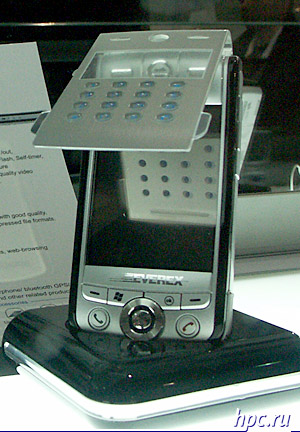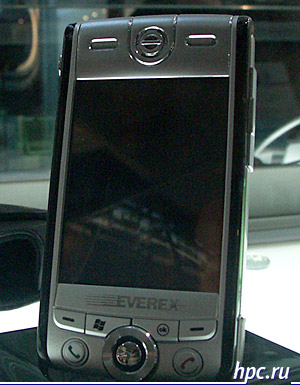Now, when the main flow of information after the CeBIT 2006 has subsided, you can stop, catch your breath and look back, noting that the dominant themes in the exhibition were held GPS-navigation and mobile digital TV. In our news lately almost every day passes information about the announcement of mobile phones equipped with the so-called DMB-TV. Not far removed from phones and PDAs and svezheanonsirovannye UltraMobile PC (UMPC). The main supplier of news about DMB-devices - the company Samsung Electronics, which provided for the last exhibition, many devices that support DMB. So in this article we describe what is, in fact, DMB, as well as along the recall of curious novelties that have not been mentioned in our resportazhah from the show.
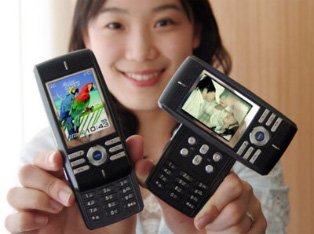 |
Abbreviation DMB stands for Digital Multimedia Broadcasting, is to say digital multimedia broadcasting. For multimedia broadcasting includes both DAB (Digital Audio Broadcasting - Digital Audio Broadcasting) technology, which has long been used in many countries, as well as DVB (Digital Video Broadcasting - Digital Video Broadcasting), which started recently and is gaining popularity on mobile devices. If desired, of course, manufacturers machines could begin mass production of devaysov supporting this technology a year or two earlier. This year, however, as you know, held the World Cup and this event is considered by many market players should play into the hands of the popularity of mobile TV. Many fans of this sport are not able to sit at home watching TV (because of work, travel or other reasons), while the mobile phone is now almost everyone. And for the opportunity to watch the matches directly on the cell are very many will be willing to buy a model with the support of DMB, and even the very service. Actually, the first model equipped with a DMB-receiver, appeared in the last year, but the greatest concentration of new products was fixed at CeBIT-2006. Technology, DVB (digital video) today is divided into two main areas - DVB-T and DVB-H. The first focused on television sets with large screen and stationary power, and the second - on mobile devices (phones, PDAs, media players, etc.) with small displays and self-powered. Standard DVB-H, on the one hand, we can assume a direct heir to the standard DVB-T, on the other - an extension of this technology. However, unlike DVB-T, where for the compression of video and audio signals using MPEG 2, DVB-H could be involved is gaining momentum H.264 algorithm, or analogs, organized by the same principle. Compressed data of a flow of IP packets. This allows the use of energy saving algorithm, which is very important for stand-alone devices that operate on battery power. Digital DVB-signal goes from the satellites, of which there are already running multiple pieces. Moreover, the signal reception is possible when driving at high speed, which makes it possible to view TV in the car. For motorists, however, produced specialized systems, but nobody forbids to use in such cases and mobile phone. In addition to marked differences from the DVB-H DVB-T, the standard is implemented a seamless transition from the coverage area of one transmitter to another area. Thus, the border crossing user is not faced with any problems such as signal distortion or interference. Many projects will be organized jointly DVB with mobile operators, which seems quite logical. By early 2006, the world has completed several pilot projects to test the standard DVB-H. It is already known about the existence of finished projects in Germany, Finland, USA, England and, of course, Korea. According to experts, the spread of this standard in the next couple of years it will happen very rapidly. So very soon, the digital mobile TV will be available for residents of North America, Europe and many Asian countries. Of course, over time these joys of life and to reach us. However, more or less intelligible information on this subject yet.As for manufacturers, for them DMB-equipped devices receivers is not a difficult technical challenge. Company Texas Instruments, known for its developments in the field of processors for mobile devices earlier this year introduced the first chips for the reception of the European standard DVB-H (is it will be used in Europe) and ISDB-T (Japanese equivalent will be DVB-H) . The difference between this chip is only in the frequency range: Receiver DTV1000 (DVB-H) supports a range of 470-750 MHz and 1.670-1.675 GHz (L-band), and DTV1001 (ISDB-T) - 470-770 MHz. As you can see, the indices of models differ only by one digit. Of course, for owners of phones with support for DMB service will be provided for a fee. On its size is difficult to say. But at the moment it is difficult to name a high price. With further development of technology, of course, it will be cheaper and it is possible that a few years and will be completely free. On the impending mass of this technology says at least the fact that a dozen booths are not too well-known Taiwanese firms actively demonstrated vserazlichnye solutions to support DVB - from the USB stick to multimediakombaynov. Well, now briefly enumerate some of the most interesting models to support digital television, which were presented at CeBIT 2006. Let's start with an interesting DVB-model presented by iRiver. V10 device can not be attributed with certainty to any category of PDAs or phones to class. Rather, this compact media player, which, among other things, will be equipped with a TV receiver. Novelty has a very compact size - the thickness of the shell is only 10 mm. In this case, the unit boasts a very impressive performance.
 |
| iRiver v10 - media player with support for mobile broadcasting |
Volume of the player's memory is 4 GB, and thus its main advantage is the 3-inch screen with a resolution of 480x272, which displays 262 thousand colors. In the role of the OS here is Windows CE 5.0. True, the immediate availability of yet unknown, as well as on price. Particularly marked at CeBIT in terms of assorted DMB-making omnivorous Samsung. However, here we talk only about one novelty Korean giant - SPH-M8000. While this device is planned to be released only in Korea but it is quite possible that in future the unit will come on the European market, albeit in slightly modified form. So this model SPH-M8000 is the first communicator Samsung, working in a network WiBro, which is an option gaining momentum standard WiMax (wireless broadband standard). This device runs on Windows Mobile 2003 SE (can later be released update to WM 5.0) and also has a DMB-tuner. A nice addition to the fiche has a TV output that enables you to watch DMB-broadcast on the big screen. M8000 enclosure is made in the slider form factor with a nice lid come. On the sliding part is located QWERTY-keyboard and a display on the upper half of the body - the standard keys. The screen itself has a diagonal of 2.8 inches, resolution - 240 x 320 pixels and displays standard 65536 colors.
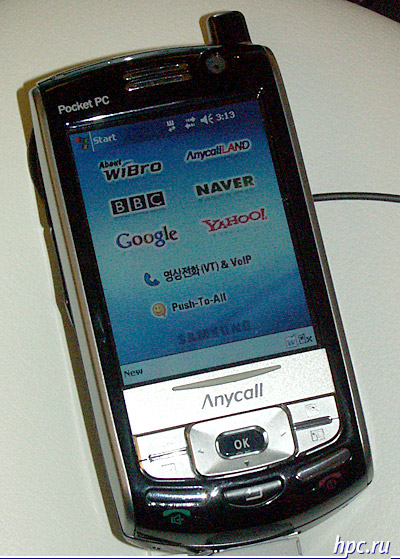 |
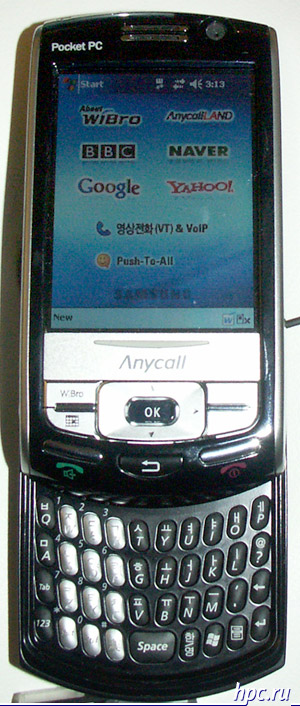 |
By design SPH-M8000 is very similar to its predecessor, i730.Of the visible differences can be noted the presence of cameras on the front side of the device, which will be designed for voice and video conferencing. The rear panel is another camera that has a matrix with a resolution of 3.1 megapixels and is designed for photo and video. As the processor uses a high-performance chip, Intel XScale PXA 272 520 MHz, the power which should suffice for all tasks assigned to the M8000. Once Speaking of Samsung, then, as promised, we will tell you about yet another device from this manufacturer, which was not mentioned in our previous articles. It is about Samsung i750. This Windows Mobile-device was showcased at last year's show even CeBIT, but its release was repeatedly postponed, and the latest data is now scheduled for the second half of 2006. It is, of course, about the European release.
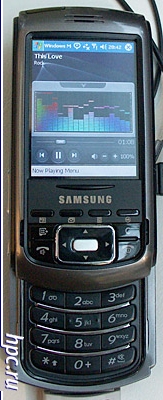 |
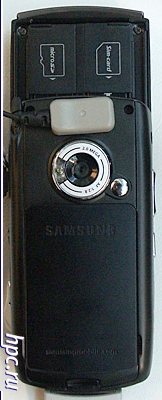 |
The model also performed at the slider, but unlike the above SPH-M8000, equipped with no QWERTY-keyboard and a regular digital, like ordinary cell phones. Samsung i750 works in networks GSM 900/1800/1900 MHz with support for GPRS / EDGE, running Windows Mobile 2003 SE and is equipped with 80 MB of memory. Of the curious fichey can distinguish a business card scanner and 2-megapixel camera with auto focus and flash. Of the wireless interfaces declared Bluetooth and Wi-Fi. But price is not reported. As the curtain represent yet another debutant CeBIT - the company Everex, known to connoisseurs for its models based on the products E-Ten. This Taiwanese manufacturer has shown in his stand communicator Neon, which is apparently an updated version of the device Qool Pocket PC from a Singaporean company Qool Labs.
Its specifications are as follows: - Operating system: Windows Mobile 5.0 Phone Edition
- Processor: Freescale I.MX21 clocked at 350 MHz
- Screen: 2.8 ", resolution - 240 x 320 pixels and the ability to display 262 thousand colors
- Phone: GSM 900/1800/1900 MHz, GPRS
- Wireless Modules: Bluetooth 1.2, Wi-Fi 802.11b and IrDA
- Expandable memory: miniSD slot
The device is equipped with a 1.3 megapixel camera with video recording capability, its dimensions are 109 x 57 x 22 mm, weight - 145 for a set of features and size to compare this device can be with cars on a platform of HTC Magician (Qtek s100, T-Mobile MDA Compact, i-mate JAM). Price and release dates are not announced Neon. At this point we do not end the cycle of materials of updates to CeBIT 2006. In the near future you will find a separate article about the devices on the new mobile platform UMPC with first impressions of working with them. To be continued ... The authors, translation:






